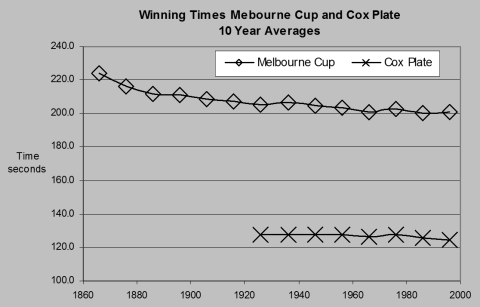Why aren’t horses bred better? Comparisons over 100 years of the Melbourne Cup, a 3,200-metre race and the Olympic 100-metre men’s sprint and the 1,500 metre and 5,000 metre races, show that humans have improved more than horses.
The Melbourne Cup winner’s time is 3 per cent less now than in the 1920’s. However, the men’s Olympic record for 100m shows an improvement of 8 per cent. The star track event, the 1,500 metre race, shows a 10 per cent improvement and the longer 5,000 metre race shows a 12 per cent improvement.

Advertisement
The answer for better human performance is better nutrition, better training regimes and track improvements along with open selection for ability.
But for the horses’ failure to do better the answer is thought to be a 300-year-old gene pool for selective breeding. English thoroughbreds are the descendants of an initial stock of 80 horses.
The Darley Arabian, the Godolphin Barb (there is dispute among historians whether this horse was an Arabian or Barb), and the Byerly Turk are responsible for perhaps 27 per cent of the breed and another 28 horses add a further 55 per cent. The Stud Book, established in 1791, was a closing of the population. However when the horses got to the colonies (United States, Australia and others) there was a little crossing outside the breed.
In the 1980’s analyses of the classic English races, the St Leger, the Derby and the Oaks all showed little or no decrease in winning times in the last 70 years. So even a little out breeding of Australian horses does not seem to have delivered better performance.
Then in 1988, two Irish geneticists, Gaffney and Cunningham, looked at the breed over 25 years from 1952 to 1977. Using more sophisticated methods of measuring form than winning times, they suggested that the overall performance of thoroughbreds was improving.
The response of owners and breeders to these performance reviews was interesting. Race winners were in the upper tail of a performance distribution. They did not represent average performance. Also horses and riders were concerned about beating other horses, not the clock and perhaps tracks were conditioned to be easy under foot and so slower. Occasionally the Melbourne Cup is run in the rain or on a very damp track and the record shows much slower times. This is an important point.
Advertisement
Thoroughbred horses are the most valuable animals on the planet supporting massive racing businesses in a number of countries. An injury on a hard track can mean the end of a horse’s racing career so perhaps tracks have progressively softened and slowed and this has cancelled out the improved performance of the breed. Of course the horses may be retired to an agreeable and valuable stud role.
Well this has raised some interesting issues. The Melbourne Cup is an open handicap race, not a race of equals. On the other hand the W.S. Cox Plate is weight for age and regarded internationally as a classic race for the best horses. Time improvement is only 2 per cent from the 1920’s.
The comparison with human performance in competitive Olympic races is valid as these are races of the best athletes against each other and not the clock. It becomes more perplexing with the Stawell Gift, a classic handicap sprint. The winning times over 100 years are near constant while Olympic athletes have clearly improved their performance. This is significantly different to the horses’ performance in the Melbourne Cup and the Cox Plate.

Perhaps a visit to the racetrack could throw some light on the issue. After all, the bookmakers are the judges of form.
Fortunately records show the winning odds and the favourites. For the Cox Plate 40 per cent of the winners were favourites. In the same period from 1922, 26 per cent of the Melbourne Cup winners were favourites reflecting the open handicapping. The balance of winners in the Melbourne Cup was no slower than the favourites. In fact even those winners with odds of greater than 15–1 were no slower than the favourites.
These “outsiders” may better represent the average performance of thoroughbreds. If this is the case then does this show that there has been no improvement in performance?
Horse racing with its strong attention to breeding and genetics has lagged behind the modern genetics of other major domestic species of animals by only initiating a program to develop a complete genetic map in 1995 well behind cat and cattle genetic mapping. The first equine, but not thoroughbred genetic maps were published in 2000 and it will be fascinating to see if this sophisticated work will help the breeding.
So maybe it is the horses’ limited breeding. But we are all descendants of a few mitochondrial Eves and Y-chromosomal Adams so perhaps the answer is to be found in the breeding of the trainers.